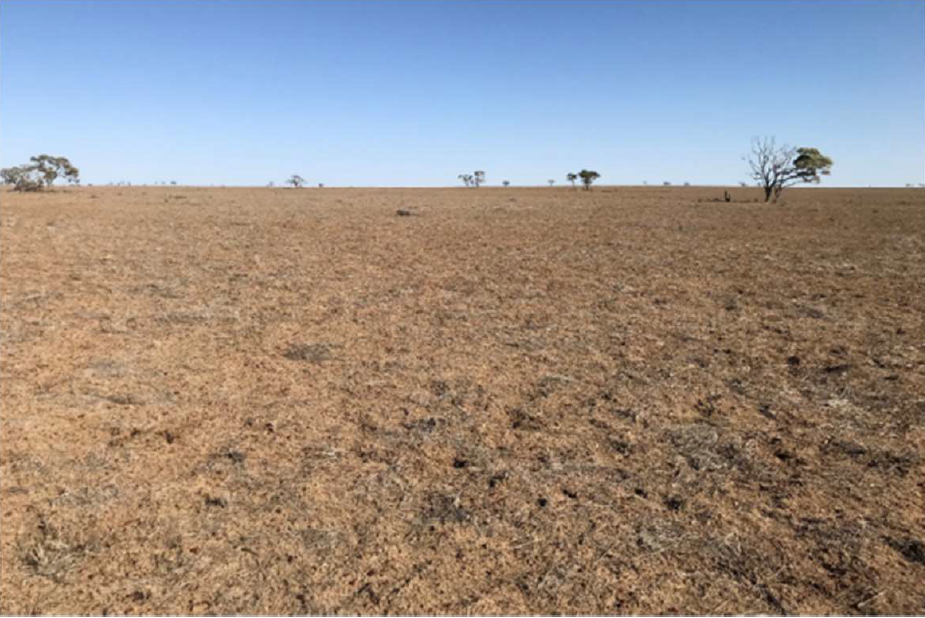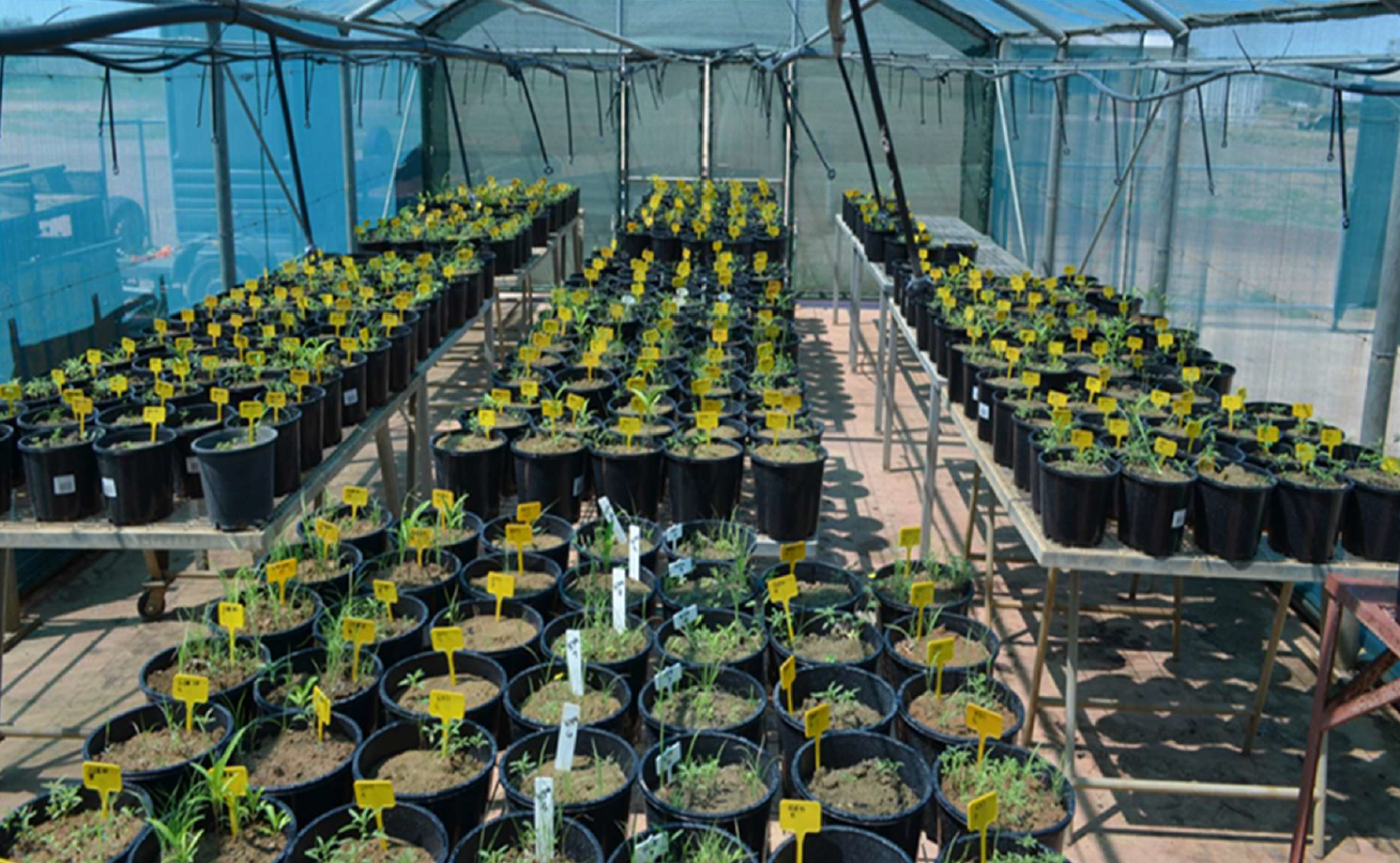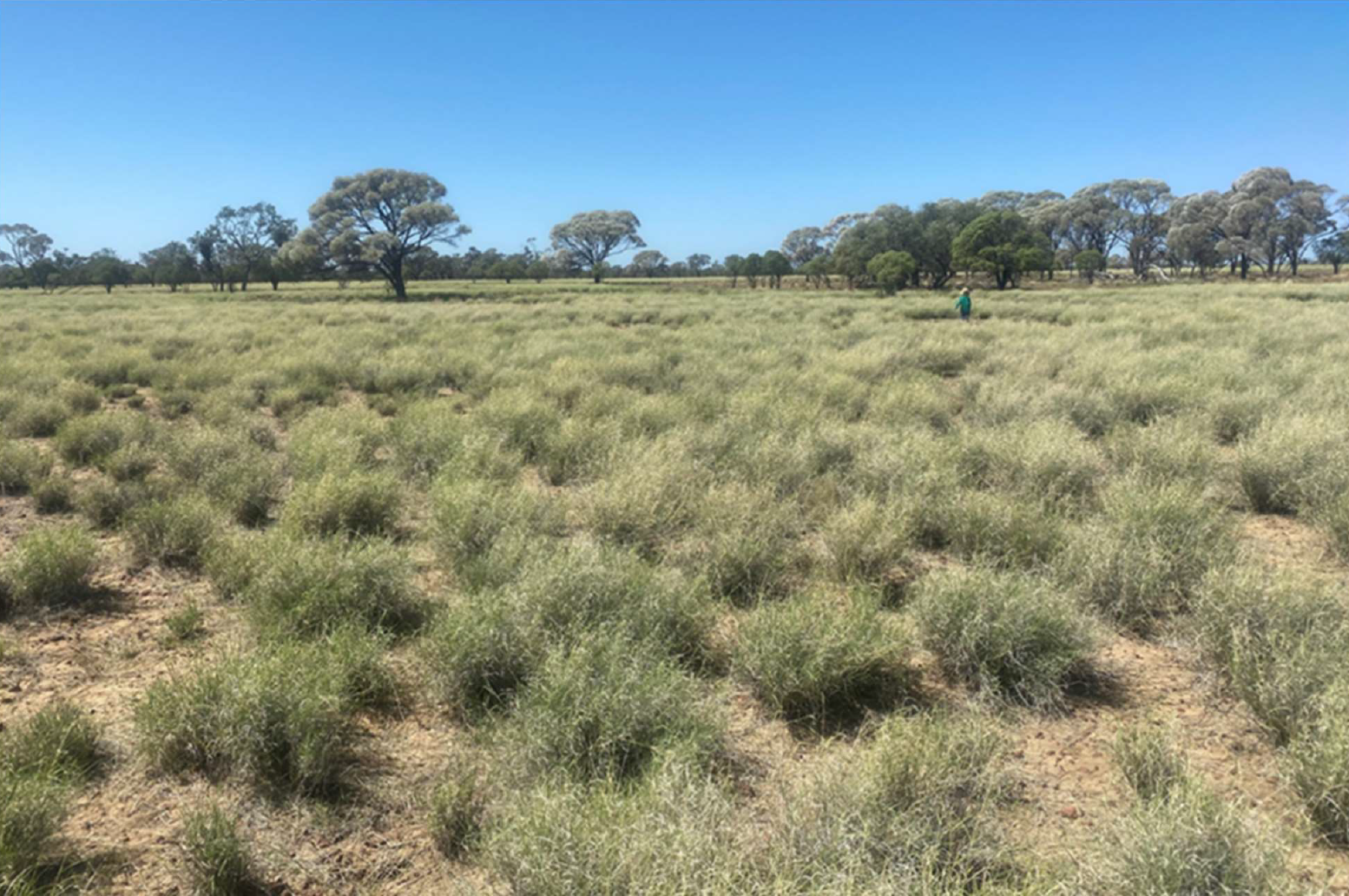Pots of hope: Assessing pasture recovery potential through soil seed bank viability testing
Summary
- A useful mix of grasses and herbage germinated indicating pasture recovery is possible.
- Grazing during pasture recovery is possible, depending upon plant species and land condition.
- When land is in either A or B condition, the ability for the pasture to recover quickly is improved.

Figure 1. Mitchell grass landscape, north-west Longreach site (1st September 2020)
Background
An impact of long-term dry conditions is the potentially reduced rate of pasture recovery, when growing conditions return. A common question from livestock producers across the central west region during 2020 was, “My paddocks look bare of Mitchell grass tussocks. Is there sufficient seed in the landscape to germinate when rain returns?” (Figure 1).
The Drought and Climate Adaptation Program’s (DCAP) GrazingFutures Livestock Business Resilience (LBR) project helps extensive livestock producers manage seasonal and business risks. The Department of Agriculture and Fisheries (DAF) team in Longreach produced this fact sheet to help livestock producers understand the potential rate of pasture recovery.

What happened?
Soil samples from four sites across the Mitchell Grass bioregion were collected. The samples were placed in 20-centimetre pots three quarters filled with sand and regularly watered. The DAF Longreach shade house (Figure 2) provided a growing environment for viable seeds in the soil samples to germinate. Seedlings were regularly counted and thinned, to prevent shading.
Soil seed bank testing
A similar technique to the one used in this project can be carried out on properties. The ideal time to collect soil samples is between July and August to avoid losing seed to insects or falling down cracks. Watering can commence in early October, when overnight minimum temperatures begin to warm above 15 degrees Celsius. Any fresh seed from the previous growing season should have completed its dormancy period and the soil temperature will be warm enough for seed germination.
Select the paddock areas where pasture recovery has not responded as expected or have consistently missed out on rainfall. Travelling away from the water point, stop about every 200 – 300 metres and with a shovel, take 5 scrapings, not deeper than 5 centimetres of topsoil and around 5 centimetres in length, from an area of approximately 20 metres in diameter.
Instead of pots, the samples can be spread out on a foil barbeque tray with some drainage holes in the bottom and watered frequently enough to keep the soil damp. Seedlings take 7-10 days to germinate with herbage species first to emerge, and grasses taking a few days longer. After a couple of weeks of growing, seedlings can be easily identified and thinned from the tray. To identify Mitchell grass (Astrebla spp.), let the seedlings grow until they produce a seed head.
Three producers joined the DAF officers during the soil collection process. Each of them commented that it was good to walk through their paddocks and see that there was live (though dormant), Mitchell grass tussocks present.

What pasture plants grew?
In the DAF shade house trial, a range of different pasture species were recorded from across the four collection sites (Table 1).
Table 1. Pasture species that germinated during the project.
| Grasses | Species | Herbage | Species |
|---|---|---|---|
| 3 P grasses Palatable Productive Perennial | Mitchell grass Forest blue grass | Desirable herbage Highly palatable | Daisy-burr Lambs tongue Bluebells Wild carrot Tar vine Pig weed |
| 2 P grasses Perennial Productive | Cup grass Star grass | Intermediate herbage Moderately palatable | Boggabri Caustic weed Mint bush Salt bush |
| 1 P grass Perennial | Feathertop | Undesirable herbage Low palatability | Burrs Goat head burr Roly Poly |
| Annual grasses | Flinders grass Love grass Button grass | Desirable legume Highly palatable | Rhyncosia |
| Intermediate legume Moderate palatability | Native lucerne |
Pasture species that germinated from the soil samples included lambs tongue, wild carrot, goat head burr, pigweed, caustic weed, native lucerne and boggabri (Figure 3).
Table 2. Sampling locations and average number of common pasture seedlings germinated per square metre (m2).
| Pasture type | Species | North west of Longreach | West of Barcaldine | East of Illfracombe | South of Longreach |
|---|---|---|---|---|---|
| 3 P grass | Mitchell grass | 15 | 8 | 6 | 21 |
| 2 P grasses | Cup grass | 77 | 8 | 6 | 17 |
| Star grass | 8 | 0 | 14 | 0 | |
| Annual grasses | Flinders grass | 231 | 4 | 17 | 2 |
| Button grass | 185 | 25 | 3 | 8 | |
| Herbage | Bluebells | 123 | 68 | 189 | 23 |
| Wild carrot | 255 | 488 | 348 | 192 | |
| Pigweed | 2553 | 144 | 37 | 275 | |
| Legume | Rhyncosia | 0 | 0 | 6 | 9 |
The greater the number of Mitchell grass seedlings and tussocks in the paddock, the faster the rate of pasture recovery. While pasture recovery is still possible with a lower density of seedlings, the rate will be much slower. Better land condition is positively linked to Mitchell grass tussock density (Table 3).
Table 3. Relationship between land condition and Mitchell grass tussock density.
| Land condition | Mitchell grass density (tussock every) |
|---|---|
| A | 0.8-1.2 metre |
| B | 2-3 metres |
| C | 20-30 metres |
| D | Almost no Mitchell grass tussocks to be seen |
For more information about Land Condition for Mitchell grasslands refer to the “Land condition in the Mitchell grasslands” fact sheet. Environmental conditions for mass Mitchell grass recruitment from seed tends to only happen every 20-30 years. A small number of seed does germinate each year and will survive providing there is sufficient rainfall.
Mitchell grass seed could be sown when paddocks are in either C or D land condition, and no seedlings germinated during soil seed bank testing, or if paddocks have been treated for heavy Prickly Acacia (Vachellia nilotica subsp. Indica) infestation. However before seeding extensive grazing areas with Mitchell grass, factors such as seed availability, seed viability, planting techniques, seasonal climate conditions and the potential for high rates of failed establishment, as well as the overall cost, should be carefully considered.
Potential toxic plant species during recovery
Species like pigweed (Portulaca oleracea) and button grass (Dactyloctenium radulans) can germinate quickly after rainfall. Livestock poisonings have been documented for pigweed (oxalate and nitrate poisoning) and button grass (nitrate poisoning, particularly when growing in nitrogen rich soil found in stock yards or lick and hay feeding locations). If livestock are not excessively hungry when put into paddocks, and there are a range of other pasture species available to graze, then pigweed and button grass in small amounts can be useful feed. However, if you are unsure, or are concerned about the amounts of pigweed and or button grass that have emerged, please contact the DAF Longreach office.

Grazing options during pasture recovery
Spelling or rest (from total grazing pressure), combined with and adequate rainfall, are important for pasture recovery, particularly for 3P grasses. Achieving rest after rain can be challenging, but an advantage on the Mitchell grasslands is the variety of herbage that can grow quickly and provide an alternative feed source, particularly for small ruminants. Table 4 describes the grazing options to promote pasture recovery by using available feed.
Table 4. Grazing options in relation to pasture response and paddock land condition.
| Pasture response | Land condition | Grazing options | |
|---|---|---|---|
| Sheep and/or goats | Cattle | ||
| Mitchell grass tussocks are reshooting as expected and desirable herbage species are germinating. | A-B | Ideal for sheep and/or goats to graze, as they prefer the herbage and will allow the tussocks to seed with follow up rain. If tussocks are slow to reshoot consider reducing livestock numbers. | Consider delaying grazing by cattle until tussocks have set seed. |
| Mitchell grass tussocks are not reshooting as expected. Desirable herbage species are germinating. | B-C | Consider reducing livestock numbers. | Consider reducing livestock numbers and delaying grazing by cattle until tussocks have set seed. |
| Mitchell grass tussocks are not reshooting as expected and seedlings present. None or limited desirable herbage germinating. | Any | If possible, rest paddocks until tussocks have set seed. If grazing must occur, consider reducing livestock numbers and the length of time they are grazing in the paddock. | |
| Mitchell grass seedlings with herbage present. | Any | Tend to prefer herbage and will leave seedlings. Allows 3P grasses and seedlings to be spelled while herbage is available. Need to monitor seedlings to make sure they are not being over-grazed. | Cattle cannot access seedlings until they are around 10 to 15 cm in height. Once at this height there is a risk that cattle may pull out seedlings. Need to monitor seedlings to make sure they are not being over-grazed. |
For more information regarding grazing management options on the Mitchell grasslands refer to Rain waiter or decision maker? Managing Mitchell grass during drought.
If you would like some help or more information, please contact Jane Tincknell, Department of Agriculture and Fisheries (DAF) Longreach on 0745 368 304.
Special thanks to the property owners for allowing samples to be collected and David Phelps, Jenny Milson, Leanne Hardwick and Emily Corbett from DAF.
Produced by: Jane Tincknell, GrazingFutures LBR, December 2021